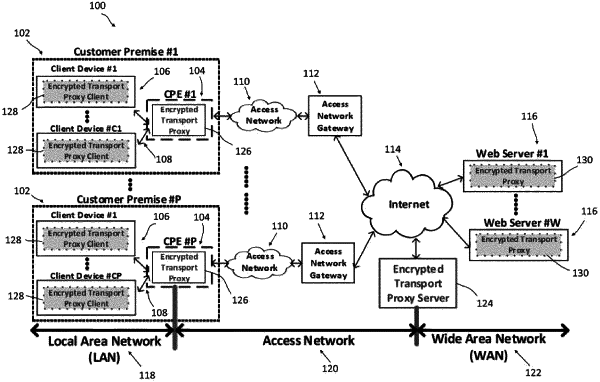| CPC H04L 67/56 (2022.05) [H04L 47/115 (2013.01); H04L 67/141 (2013.01); H04L 69/163 (2013.01); H04L 69/164 (2013.01); H04L 69/22 (2013.01)] | 20 Claims |

|
1. A distributed proxy device for transmitting data packets between client devices and web servers over an access network using an Encrypted Transport (ET) Proxy Backbone Protocol that is independent of an ET protocol in use between the client device and the web server, the distributed proxy device comprising:
a network interface for sending and receiving data packets to and from a client device or a web server;
an ET Proxy Backbone Protocol module configured to:
set up ET Proxy Backbone connections with another distributed proxy device, each ET Proxy Backbone connection including multiple ET Proxy Backbone channels for transmitting ET proxy packets having different QoS classes, each ET Proxy Backbone channel including a separate queue;
schedule transmissions of the ET proxy packets from each respective queue;
multiplex the ET proxy packets from each respective queue via the associated ET Proxy Backbone channel;
perform local recovery of network impairments over the access network and
perform congestion control to prevent packets from client devices and web servers from causing network congestion to the access network;
a connection selection module configured to select data packets, received via the network interface, that are to be proxied using the ET Proxy Backbone Protocol according to a set of predetermined rules;
a connection manager module configured to:
maintain an ET proxy connection table of established ET Proxy Backbone connections that includes connection information for each of the established ET Proxy Backbone connections;
initiate establishment of new ET Proxy Backbone connections for data packets to be proxied for which no ET Proxy Backbone connection has been established; and
identify, for each of the data packet to be proxied, the ET Proxy Backbone connection from the ET Proxy connection table established for the data packet to be proxied and obtain the connection information for the identified ET Proxy Backbone connection;
a traffic characterization module configured to passively monitor packet information of the data packets to be proxied;
an ACK reduction module configured to reduce a number of data packets to be proxied over the access network based on the monitored packet information;
a classifier module configured to:
classify each of the data packets to be proxied into one of the QoS classes based on the monitored packet information;
generate new ET proxy packets from the data packets to be proxied and based on the connection information for the ET Proxy Backbone connection for the respective data packets to be proxied;
put the new ET proxy packet into the queues for the ET Proxy Backbone channel of the ET Proxy Backbone connections to use for the new ET proxy packets according to the QoS class of the respective new ET proxy packets.
|